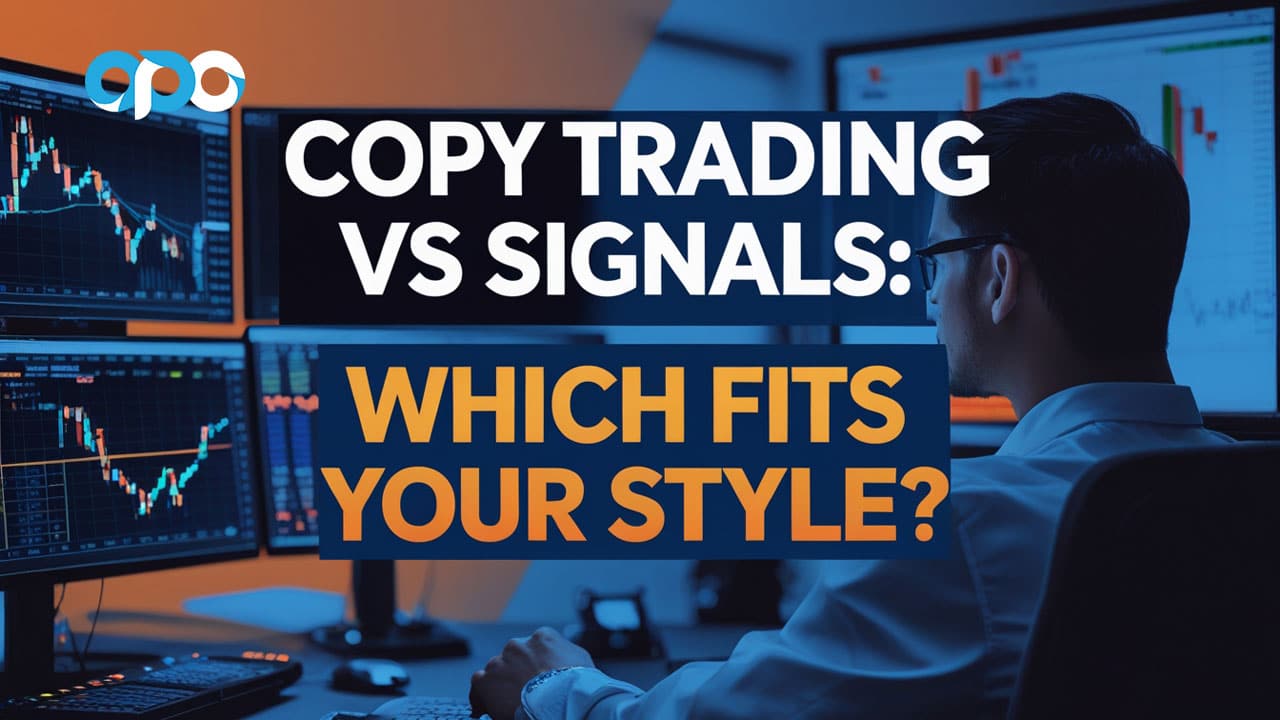In today’s fast-paced financial markets, traders are constantly seeking efficient ways to participate and profit. Two popular approaches have emerged as frontrunners for those looking to leverage external expertise: copy trading and trading signals. For anyone partnering with an online forex broker, understanding the distinction in the copy trading vs signals debate is crucial for optimizing trading outcomes and managing risk effectively. This comparison of copy trading vs signals is essential for modern traders.

Copy trading represents an automated approach where your account mirrors the trades of experienced professionals, requiring minimal intervention. In contrast, trading signals provide market insights and trade recommendations that you can choose to execute manually. While both methods tap into external expertise, they differ significantly in execution, control, and learning potential, making the choice between copy trading vs signals a very personal one.
This comprehensive guide explores the nuances of copy trading vs signals, examining their mechanics, benefits, limitations, and suitability for different trader profiles. Whether you’re a novice seeking to shortcut the learning curve or an experienced trader looking to diversify strategies, this comparison will help you determine which approach in the copy trading vs signals spectrum aligns with your trading objectives, time availability, and personal preferences.
What is Copy Trading?
Copy trading is a form of automated trading that allows investors to automatically replicate the trades of experienced and successful traders in real-time. When you engage in copy trading, you link a portion of your trading account to mirror the actions of your chosen trader. Every position they open, close, or modify is proportionally executed in your account without requiring any manual intervention from your side. This automation is a key factor when considering copy trading vs signals.

Most copy trading platforms display detailed statistics and performance metrics of potential traders to copy, including their risk score, average trade duration, preferred instruments, and historical performance. This transparency allows you to make informed decisions about whose trading activity you want to replicate.
Key Features
Copy trading comes with several distinctive features that set it apart from other trading approaches:
- Automatic Trade Execution: Once you’ve selected a trader to copy, all their trading activities are automatically replicated in your account. If they open a position with 5% of their portfolio, the system will allocate the same percentage of your dedicated funds to that position.
- Proportional Position Sizing: The platform calculates the appropriate position size for your account based on the percentage allocation the copied trader uses. This ensures the risk level remains proportionate to your investment amount.
- Real-Time Synchronization: Any changes the copied trader makes to their positions—adjusting stop losses, taking partial profits, or closing trades—are instantly mirrored in your account.
- Trader Performance Metrics: Comprehensive statistics about potential traders to copy, including their historical returns, drawdowns, risk levels, and trading frequency.
- Portfolio Diversification: Many platforms allow you to allocate portions of your capital to different traders, creating a diversified portfolio of trading strategies.
Benefits
Copy trading offers several advantages that make it attractive to many market participants:
- Time Efficiency: Once set up, copy trading requires minimal time commitment. You don’t need to analyze markets, identify opportunities, or manage trades actively.
- Accessibility for Beginners: Newcomers can participate in markets without deep knowledge of trading strategies or technical analysis.
- Emotional Detachment: Trading decisions are not influenced by your emotions since they’re executed automatically, eliminating fear and greed from the equation.
- Portfolio Diversification: By copying multiple traders with different strategies and market focuses, you can achieve broader market exposure and potentially reduce risk.
- Learning Opportunity: While more passive than signal trading, copy trading still allows you to observe successful trading strategies in action, potentially contributing to your trading education.
Read More: What is Copy Trading in Forex
What are Trading Signals?
Trading signals are recommendations or alerts that provide information about potential trading opportunities. These signals typically include suggested entry points, stop-loss levels, and take-profit targets for specific financial instruments. Unlike copy trading, signals don’t execute trades automatically—they merely provide the analysis and suggestion, leaving the decision and execution to you. This manual control is a major point in the copy trading vs signals comparison.

Signals can originate from professional analysts, algorithmic systems, or technical indicators. They may be delivered through various channels, including email, SMS, social media platforms, or dedicated messaging applications like Telegram or WhatsApp.
Key Features
Trading signals have distinctive characteristics that define how they function:
- Manual Trade Execution: Upon receiving a signal, you must manually enter the trade in your trading platform, giving you full control over whether and how to implement the recommendation.
- Detailed Analysis: Most quality signals include not just entry/exit points but also rationale behind the recommendation, often incorporating technical or fundamental analysis.
- Flexible Implementation: You can modify the suggested parameters based on your risk tolerance, account size, or market perspective.
- Variety of Timeframes: Signals can be tailored for different trading styles, from day trading (focusing on minute or 5-minute charts) to swing trading (targeting trends spanning days or weeks).
- Platform Independence: Since you execute trades manually, signals can be used with any broker or trading platform of your choice.
Benefits
Trading signals offer several advantages that appeal to many traders:
- Greater Control: You maintain complete discretion over your trading decisions, choosing which signals to follow and which to ignore.
- Educational Value: Quality signals often include market analysis, helping you understand the reasoning behind trading decisions and potentially improving your own analytical skills.
- Customizable Risk Management: You can adjust position sizes, stop-loss levels, and take-profit targets according to your personal risk tolerance rather than copying someone else’s risk parameters.
- Broker Flexibility: Since signals are just information, you can use any broker that offers the instruments you want to trade, potentially accessing better pricing and lower costs.
- Strategy Diversification: You can follow multiple signal providers with different approaches, creating a diversified trading methodology.
Key Differences Between Copy Trading and Signals
The core of the copy trading vs signals discussion lies in these fundamental differences:
Execution Process
The most fundamental difference between copy trading vs signals lies in how trades are executed:
With copy trading, the process is fully automated. Once you allocate funds to copy a trader, all their trading activities are automatically replicated in your account without any action required from you. This hands-off approach makes copy trading particularly attractive for those with limited time when weighing copy trading vs signals.
In contrast, signal trading requires manual execution. After receiving a signal, you must log into your trading platform, analyze the recommendation, and decide whether to place the trade. This gives you greater control but demands more time and attention, a key factor in the copy trading vs signals choice.
Learning Opportunities
The educational aspect differs significantly between these approaches in the copy trading vs signals landscape:
Copy trading provides limited direct learning as the strategy execution happens “behind the scenes.” While you can observe outcomes, you might not fully understand the methodology or rationale behind specific trades. Some platforms do offer insights into the copied trader’s thinking, but this is typically less detailed than with signals.
Signal trading, however, often includes educational components. Quality signals frequently provide analysis explaining why a particular trade setup is attractive, which can help you develop your own analytical skills. This educational aspect makes signals particularly valuable for those looking to improve their trading knowledge.
Risk Management
How risk is controlled varies between the two approaches when comparing copy trading vs signals:
In copy trading, risk management is largely determined by the trader you’re copying. While most platforms allow you to set maximum drawdown limits, the specific risk per trade typically follows the pattern established by the copied trader, adjusted proportionally to your investment amount.
With trading signals, you have complete control over risk management. You decide the position size for each trade and can modify the suggested stop-loss and take-profit levels based on your personal risk tolerance. This flexibility allows for more customized risk control but requires you to actively manage these parameters.
Customization
The degree of flexibility differs substantially in the copy trading vs signals comparison:
Copy trading offers limited customization. While you can select which traders to copy and how much to allocate to each, you generally can’t modify individual trades. Some platforms allow you to exclude certain instruments or set maximum risk per trade, but the core strategy remains that of the copied trader.
Signal trading provides extensive customization options. You can cherry-pick which signals to follow, adjust entry and exit points, modify position sizes, or even combine the signal with your own analysis to refine the approach. This high degree of flexibility appeals to traders who want to maintain personal control over their trading strategy.
Platform Requirements
The technical requirements differ between the approaches:
Copy trading typically requires you to use the same platform or broker as the trader you’re copying. This can limit your options and potentially result in higher trading costs if that platform doesn’t offer competitive spreads or commissions.
Signal trading allows you to choose any broker or platform, as you’re simply receiving information and executing trades independently. This freedom enables you to select the most cost-effective or feature-rich platform for your needs.
Pros and Cons
Understanding these pros and cons is key in the copy trading vs signals decision.
Copy Trading
Pros:
- Requires minimal time commitment after initial setup
- Removes emotional decision-making from the trading process
- Provides access to professional trading strategies without technical knowledge
- Offers transparent track records of traders to evaluate before copying
- Enables participation in markets you might be unfamiliar with
Cons:
- Limited control over individual trading decisions
- Performance is entirely dependent on the copied trader’s success
- Usually requires using specific platforms or brokers, potentially limiting options
- May involve higher costs through performance fees or wider spreads
- Provides fewer learning opportunities for developing your own trading skills
Trading Signals
Pros:
- Maintains full control over trading decisions and execution
- Provides valuable learning opportunities through analytical insights
- Allows flexibility in broker selection, potentially reducing trading costs
- Enables customization of position sizing and risk management
- Permits selective implementation based on your assessment
Cons:
- Requires more time and attention for trade execution and management
- Involves emotional elements that may affect decision quality
- Necessitates basic market knowledge to evaluate signal quality
- May lead to delayed execution and missed opportunities
- Quality and reliability can vary significantly between signal providers
Read More: Social Trading vs Copy Trading
Which Strategy is Better for You?

Determining the better fit in the copy trading vs signals equation depends on several critical factors:
Experience Level
For Beginners: Copy trading often provides an easier entry point for novices. Without deep market knowledge, beginners can participate in sophisticated trading strategies by copying experienced traders. The automated nature also reduces the potential for costly execution errors.
For Experienced Traders: Trading signals may appeal more to those with existing market knowledge. Experienced traders can better evaluate signal quality, incorporate signals into their existing strategy, and appreciate the analytical insights provided.
Time Availability
Limited Time: If you have a full-time job or other commitments that prevent active trading, copy trading offers a way to participate in markets with minimal time investment. Once set up, it requires only periodic monitoring to ensure performance meets expectations.
More Available Time: If you can actively monitor markets and execute trades promptly, signals provide greater control and potentially better learning opportunities. The time investment can be worthwhile for the additional insights and flexibility gained.
Control Preference
Hands-Off Approach: If you prefer a passive investment style or don’t want the stress of making trading decisions, copy trading provides a more automated solution with less personal involvement.
Active Management: If you value making your own decisions and want to maintain control over every aspect of your trading, signals offer the information while leaving execution entirely in your hands.
Learning Goals
Quick Market Participation: If your primary goal is market exposure and potential returns rather than developing trading skills, copy trading provides a more direct path.
Skill Development: If you aim to become a proficient independent trader eventually, signals offer more educational value, helping you understand market analysis while still providing expert guidance. Making the right choice in the copy trading vs signals dilemma aligns with these goals.
Advanced Techniques for Each Approach
For Copy Trading
- Diversification Across Traders: Instead of allocating all your copy trading funds to a single trader, consider spreading your investment across multiple traders with different strategies, timeframes, and market focuses. This diversification can help reduce risk and smooth returns.
- Regular Performance Review: Schedule monthly reviews of your copied traders’ performance. Look beyond simple profit/loss metrics to examine risk-adjusted returns, drawdown management, and consistency. Be prepared to reallocate from underperforming traders to those showing more promising results.
- Partial Copying with Manual Overlay: Some advanced platforms allow you to automatically copy trades but maintain the option to manually intervene. This hybrid approach enables you to benefit from automation while retaining the ability to override decisions when you have a strong conviction.
- Risk Limitation Setting: Utilize advanced risk management features like maximum drawdown limits, which automatically disconnect copying if losses reach a predetermined threshold. This protects your capital while allowing the strategy to work through normal market fluctuations.
For Signal Trading
- Signal Aggregation: Rather than following a single signal provider, consider using multiple sources with complementary approaches. When several independent providers identify the same opportunity, it may represent a higher-probability trade setup.
- Correlation Analysis: Analyze the correlation between different signal providers to ensure you’re actually achieving diversification. Two providers using similar methodologies might generate nearly identical signals, creating concentration risk rather than diversification.
- Custom Execution Rules: Develop personal rules for signal implementation—for example, only taking trades that align with the broader market trend, have a minimum risk-reward ratio, or occur during specific market hours when liquidity is optimal.
- Signal Filtering Framework: Create a systematic framework for evaluating signals based on criteria like alignment with fundamental outlook, current market volatility, correlation with economic events, and technical confluence. This helps prioritize higher-quality opportunities.
Pro Tips for Advanced Traders
- Combine Both Approaches Strategically: Consider allocating a portion of your trading capital to copy trading for consistent exposure while using signals to inform discretionary trades with another portion. This hybrid approach leverages the strengths of both methods in the copy trading vs signals spectrum.
- Develop a Signal Validation System: Create your own secondary confirmation system for trading signals. For example, you might only take signal trades that also satisfy your personal technical criteria or align with fundamental expectations.
- Track and Analyze All Outcomes: Maintain detailed records of both copied trades and signal-based trades. Regularly analyze the performance to identify which approach works better for particular market conditions or instrument types.
- Consider Counter-Cyclical Allocation: When your copied traders are underperforming, signals might provide better opportunities, and vice versa. Being flexible between the approaches based on performance cycles can optimize overall results.
- Build Relationships with Signal Providers: Many high-quality signal providers offer communication channels for clarification and education. Engaging actively can provide deeper insights into their methodology, enhancing your learning experience.
Read More: What is Social Trading in Forex
OpoFinance Services
For traders navigating the choice between copy trading and signals, selecting the right broker is equally important. OpoFinance, an ASIC-regulated broker established in 2021, offers comprehensive services that support both trading approaches:
- Multiple Advanced Trading Platforms – Trade seamlessly on MT4, MT5, cTrader, and OpoFinance’s proprietary OpoTrade platform, providing flexibility for both copy trading and signal execution
- Innovative AI Trading Tools – Leverage cutting-edge technology with AI Market Analyzer for deeper market insights, AI Coach for strategy improvement, and AI Support for immediate assistance
- Social & Prop Trading Solutions – Access robust copy trading functionality and proprietary trading opportunities in a secure, regulated environment
- Secure & Flexible Transactions – Enjoy safe and convenient deposits and withdrawals through multiple methods, including cryptocurrency payments, all with zero fees from OpoFinance
- Regulated Trading Environment – Benefit from the security of ASIC regulation and Financial Commission membership, ensuring proper oversight and client protection
OpoFinance combines competitive trading conditions with maximum leverage of 1:500 and a low minimum deposit of $100, making it accessible for traders at all levels exploring copy trading vs signals strategies.

Ready to elevate your trading experience with professional tools for both copy trading and signals? Visit OpoFinance today and discover the advantages of trading with a regulated broker.
Conclusion
The choice between copy trading and signals ultimately depends on your personal trading goals, available time, experience level, and desire for control. copy trading vs signals represents a fundamental decision about how actively involved you want to be in your trading journey. Copy trading offers a more hands-off, automated approach ideal for those seeking market participation with minimal time investment. Trading signals provide greater control, customization, and learning opportunities but require more active involvement and market knowledge. Understanding the copy trading vs signals dynamic is key to making the right choice.
Neither approach is inherently superior—each serves different needs and preferences. Many successful traders even incorporate both methods, using copy trading for consistent market exposure while utilizing signals to inform discretionary trades in specific situations. The flexibility within the copy trading vs signals framework allows for such hybrid strategies.
As markets evolve and technology advances, the line between these approaches continues to blur. Modern platforms increasingly offer hybrid solutions that combine aspects of both copy trading and signals, allowing for customized automation with varying degrees of manual oversight.
The most important factor is alignment with your personal trading journey. Whether you prioritize convenience and automation or control and education, understanding the distinct characteristics of copy trading vs signals enables you to make an informed choice that supports your financial goals and trading style.
Key Takeaways
- Copy trading automatically replicates trades of selected traders in your account, while trading signals provide recommendations requiring manual execution. This is the central point in the copy trading vs signals comparison.
- Copy trading excels in time efficiency and emotional detachment but offers limited control; signals provide greater flexibility and learning opportunities but demand more time and knowledge.
- Platform requirements differ significantly—copy trading typically restricts you to specific platforms, while signals can be used with any broker.
- Beginners and time-constrained traders often benefit more from copy trading, while experienced traders seeking control and education might prefer signals when deciding on copy trading vs signals.
- Advanced strategies for both approaches include diversification across multiple traders or signal providers and implementing structured evaluation frameworks.
- Many successful traders use a hybrid approach, leveraging the automation of copy trading alongside the insights and flexibility of trading signals.
- Selecting a regulated broker with appropriate tools and conditions is crucial for effective implementation of either strategy in the copy trading vs signals landscape.
How do fees compare between copy trading platforms and signal providers?
Fee structures differ significantly between copy trading and signal services. Copy trading platforms typically charge through spreads, commissions, or performance-based fees (often 10-20% of profits generated). Some also charge monthly subscription fees. Signal providers usually operate on subscription models ranging from $10 to several hundred dollars monthly, depending on the quality and exclusivity. While signal services have more transparent fixed costs, copy trading fees can sometimes be less visible as they’re integrated into trading costs. When evaluating total cost in the copy trading vs signals context, consider both explicit fees and the hidden costs of execution quality and potential slippage.
Can trading signals be automated to function like copy trading?
Yes, trading signals can be automated through trading bots or Expert Advisors (EAs) that monitor signal feeds and execute trades automatically. This creates a hybrid approach that combines the analytical advantages of signals with the automation of copy trading, blurring the lines in the copy trading vs signals discussion. To implement this, traders need to use a compatible trading platform (like MetaTrader) and either program their own EA or purchase one that integrates with their signal provider. While this approach offers more customization than standard copy trading, it requires technical setup knowledge and ongoing maintenance to ensure the automation correctly interprets and executes the signals.
How does market volatility impact the effectiveness of copy trading versus signals?
Market volatility affects both approaches differently when considering copy trading vs signals. In highly volatile markets, copy trading can be advantageous as it executes trades instantly without emotional hesitation, potentially capturing rapid market movements that manual execution might miss. However, during extreme volatility or market dislocations, copied strategies may underperform if they weren’t designed for such conditions. With signals, traders have the flexibility to adjust recommendations based on volatility—perhaps reducing position sizes or avoiding certain setups entirely. This adaptability can be valuable during unstable markets, though it requires quick decision-making under pressure. The best approach during volatility depends on the specific strategies being copied or signaled and your own risk management discipline.







